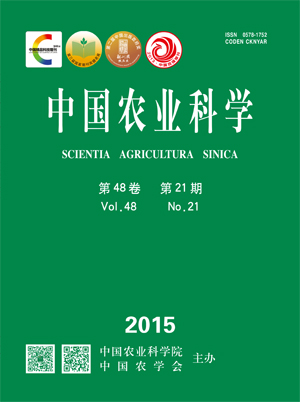-
Agronomic and Physiological Characterization of the Wide Adaptable Wheat Cultivar Zhongmai 175 Under Two Different Irrigation Conditions
- LI Xing-mao, NI Sheng-li
-
Scientia Agricultura Sinica. 2015, 48(21):
4374-4380.
doi:10.3864/j.issn.0578-1752.2015.21.017
-
 Abstract
(
412 )
Abstract
(
412 )
 HTML
(
1 )
HTML
(
1 )
 PDF (332KB)
(
1029
)
PDF (332KB)
(
1029
)
 Save
Save
-
References |
Related Articles |
Metrics
【Objective】This study aims to differentiate the agronomic and physiologic characteristics among three winter wheat cultivars under water-limited and full irrigated conditions, and to identify the traits closely associated with the adaptability of Zhongmai 175, which will provide the reference in a breeding program for improving wheat adaptability.【Method】Three cultivars were grown in the 2011-2012 and 2012-2013 cropping seasons at the CAAS, Beijing Experimental Station, and at Gaoyi in Hebei province. Randomized complete blocks were used to incorporate water in two levels with two replications. Heading date, plant height, grain yield and components, ground cover after green recover stages (GC), normalized difference vegetation index before heading (NDVIv) and at mid-filling (NDVIg), SPAD before heading (SPADv) and at mid-filling(SPADg), leaf senescence score at mid-filling (LSS), leaf area index before heading (LAIv) and at mid-filling (LAIg), leaf senescence rate (LSR), and leaf rolling score (LRS) were measured. The differences of traits were analyzed among three varieties. 【Result】All traits except kernel number per spike, LAIg, and SPADv showed significant genetic variation. The values of all traits under full irrigation were increased more than those under limited irrigation. Grain yield, spike number per square meter, thousand kernel weight, plant height, and heading date of Zhongmai 175 were increased 1 072.6 kg·hm-2, 104, 0.9 g, 7.2 cm, and 3 days, while those of Jingdong 8 were 1 274 kg·hm-2, 15, 1.8 g, 9 cm, and 2 days, and Aikang 58 were 991.7 kg·hm-2, 47, 1.7 g, 6.2 cm, and 3 days. Grain yield and spike number per square meter of Zhongmai 175 were 647.3-1 505.8 kg·hm-2 and 38-68.8 higher than other cultivars. Plant height, GC, NDVIv, NDVIg, SPADg, LSR, and LRS of Zhongmai 175 were 75.8 cm, 13.2%, 0.64, 0.55, 56.5, 14.10, and 4.0, respectively. The water sensitive index of Zhongmai 175 was 0.86, 0.64, 0.94, 0.61, and 0.57 for yield, thousand kernel weight, plant height, SPADg, and LAIv, respectively. 【Conclusion】 Zhongmai 175 showed the highest yield and spike number per unit area, early maturity, and semi-dwarf in limited irrigation and full irrigation areas. It was characterized by higher ground cover after the green recover stages, but lower normalized difference vegetation index in the heading and mid-filling stages, higher SPADg, and higher leaf rolling score. The grain yield, thousand kernel weight, plant height, SPADg, and LAIv were insensitive to water, but the spike number and kernel number of Zhongmai 175 were sensitive.









